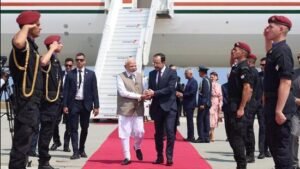
Why in News:
US President Donald Trump, in a sudden move in April 2025, announced tariffs on 490 products imported from select countries. This protectionist step, labeled as part of a larger economic strategy, is seen as a pressure tactic to bring trading partners (notably China) back to the negotiating table. It also has implications for India, which must carefully recalibrate its export policy and market strategy to benefit from the unfolding geopolitical-economic shifts.
Introduction:
Tariffs — a kind of tax imposed on imported goods — are often used as economic weapons in global trade. The Trump administration’s move is a continuation of his earlier trade war policies (2018–2020), with new emphasis on:
- Reducing the US trade deficit,
- Countering China’s economic dominance,
- Pressuring allies and competitors to revise trade terms,
- And indirectly, creating new trade opportunities for countries like India.
The move has sparked debates on the role of tariff diplomacy, free trade, and how developing nations like India can benefit by filling trade gaps left by sanctioned or blocked Chinese exports.
Key Takeaways – Point-Wise Summary
- What Did Trump Announce?
- Imposed tariffs on 490 products from select countries, especially targeting China.
- The goal is to reduce the US trade deficit and revive manufacturing at home.
- It is part of a “shock-and-awe” economic strategy to force countries into trade renegotiation.
- The Bigger Goal – Trade Negotiation Strategy
- Slashing the US trade deficit, which stood at $1.2 trillion in 2024.
- Reviving US manufacturing, especially in sectors already affected by imports.
- Forcing bilateral trade deals (like with Japan, South Korea, and now eyeing India).
- Claims that free trade deals (e.g., WTO framework) haven’t served US interests.
- China’s Economic Impact and Reactions:
- China had a trade surplus of $440 billion with the US in 2024.
- Trump’s tariffs target that imbalance.
- China is now trying to:
- Strengthen trade ties with ASEAN and friendly nations.
- Reduce reliance on US exports.
- Focus on self-reliant manufacturing, especially in critical sectors.
- The Global Trade Imbalance
- The US imports much more than it exports — a classic trade imbalance.
- Tariffs are seen as a way to create local jobs and reduce dependence on foreign suppliers.
- Trump’s aim is to reverse outsourcing trends and punish “trade abusers”.
- India’s Position in the Trade Matrix
- India has a moderate trade surplus with the US.
- The US is India’s second-largest market (after EU), with $85.1 billion exports in 2023.
- China’s loss in export volumes opens a huge opportunity for Indian exporters.
- Sectors that could benefit:
- Electronics
- Textiles
- Agri-exports
- Pharmaceuticals
- Challenges for India
- India must scale up production capacity.
- Improve compliance with US safety and quality standards.
- Reform domestic logistics and infrastructure.
- Enhance global competitiveness, especially in high-value-added sectors.
- Policy Suggestions for India
To capitalize on this opportunity, India needs to:
- Revamp SEZs (Special Economic Zones) with better facilities and logistics.
- Promote Make in India for global markets.
- Focus on WTO-compliant export incentives.
- Attract global companies exiting China through favorable land, labor, and tax reforms.
- Push India’s agri-exports to $100 billion by 2030.
- Lessons from China’s Past Mistakes
- China has relied too heavily on low-cost manufacturing.
- This left it vulnerable when the US imposed punitive tariffs.
- India must avoid overdependence on a single market or product category.
- It should diversify trade relationships, including Africa, ASEAN, and Latin America.
- Strategic Global Context
- Trade wars reflect a larger shift in the global order — from multilateralism to protectionism.
- WTO mechanisms are being bypassed, and bilateralism is gaining ground.
- Countries are competing to be the “next manufacturing hub” in a China-plus-one strategy.
- Summary of Authors’ View
- Trump’s tariff strategy is not irrational but deeply calculated.
- India needs to play its economic cards wisely, ensuring it is not caught between the US-China rivalry but rather benefits strategically.
- For this, India must combine domestic reforms with foreign policy assertiveness.
Key Concepts & Terms Explained (Notes for CLAT Aspirants)
Term | Meaning |
Tariff | A tax imposed on imported goods, meant to protect domestic industries or influence trade patterns. |
Trade Deficit | When a country imports more than it exports. |
WTO | World Trade Organization – regulates international trade agreements and dispute resolution. |
SEZ (Special Economic Zone) | Designated areas with special economic regulations to attract foreign investment and boost exports. |
Protectionism | Economic policy of restricting imports to protect domestic industries. |
ASEAN | Association of Southeast Asian Nations – a regional grouping promoting economic cooperation. |
Bilateralism | Trade agreements between two countries, often outside multilateral institutions like the WTO. |
China Plus One Strategy | A business strategy to diversify manufacturing beyond China by investing in alternate countries like India or Vietnam. |






